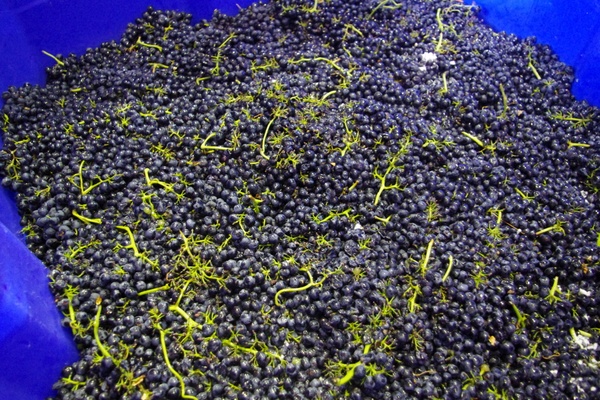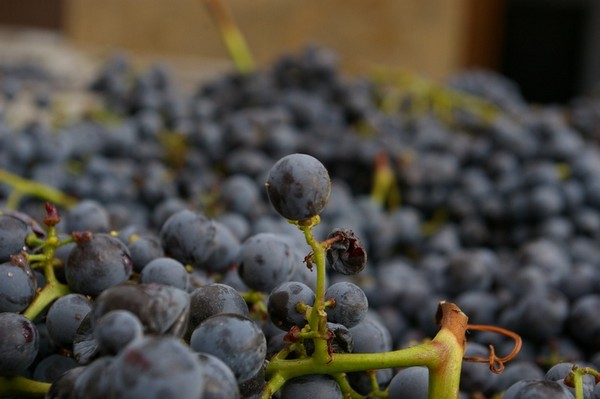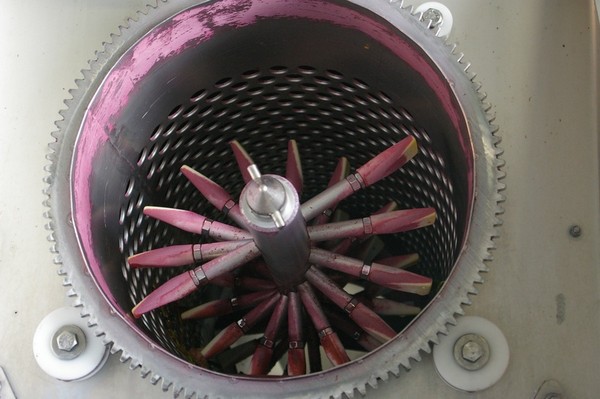|
Whole
bunches and stems in red winemaking
Jamie Goode takes a closer look at the deliberate choice by many
winemakers to leave the stems in their red wine fermentations

Let’s talk geeky for a bit. The
subject? Whole bunch fermentation in red winemaking. It’s a hot
topic.
What is it exactly? For most red wines,
the first stage of winemaking is to separate the grape berries from
the stems (here, the term ‘stem’ is used to refer to the main
axis of the cluster of grapes, known as the rachis, plus the bits
that attach the berries to this, known as pedicels). The stems make
up about 2–5% of the weight of the cluster, and they vary in
colour from green to brown.
This destemming can take place in the
vineyard (where machine harvesting is practiced), or in the winery,
with a crusher destemmer. Some very swanky properties even do
ultra-precise hand destemming, but that’s very rare and expensive.
Not destemming, and using the whole
bunches with the stems in the fermentation is widely considered to
be old fashioned and rustic. But it is coming back into fashion for
those who appreciate elegance and interest in their wines,
especially for Pinot Noir and Syrah.
‘Clearly, in Burgundy at the moment
there is a tendency to move towards stems,’ says Burgundy expert
Jasper Morris. ‘I can see two main reasons for this,’ he says.
‘One is that Henri Jayer, who hated stems, is dead. And the other
is that with global warming, the stems are more often riper than
they used to be.’ Jayer, a trememdously high-profile grower,
influenced many to move away from stems, and until recently this was
the direction being taken across the region. And the popularity of
destemming was linked
with a corresponding reduction in greenness and rusticity in many
red Burgundies, so there was a good reason for doing it. In a sense,
in the past people used stems by default, and the results weren’t
always good. Now the choice to use stems is an active one, so the
people doing it are doing a better job with it.

Jeremy Seysses
Jeremy
Seysses
at Domaine Dujac uses between 65% and 100% whole cluster
fermentations depending on the cuvée. ‘We have the feeling that
we get greater complexity and silkier tannins with whole cluster
fermentation,’ he shares. ‘In high acid vintages, it helps round
things out, and in high ripeness vintages, it brings a freshness to
the wines.’ For Seysses, the decision about whether or not to
destem depends on a number of factors. ‘Some terroirs don't seem
to do so well with whole cluster. The whole cluster character
rapidly becomes dominant and can appear "gimmicky", it
doesn't mesh well with the wine and can give the illusion of
complexity, but it feels superficial,’ he explains. ‘Of our
holdings, I like destemming a little more for the Gevrey vineyards
than the others.’ He also tends to destem more frequently the
grapes from younger vineyards with bigger clusters, and in vintages
with rapid end of season ripening, where the ripening may be a
little more uneven.
‘I
normally find a strong correlation between the better sites and the
amount of stem/whole bunch I am able to use,’ says Mark Haisma, an
Australian working as a micronegociant in Burgundy and Cornas.
‘The stems from the best sites are generally cleaner and richer in
character.’
Well known Aussie winemaker, Tom Carson
of Yabby Lake, admits that he likes to play
around a bit with whole bunches in his Pinot Noir ferments. ‘I am
still experimenting, and I’m reluctant to go in too hard.
When it’s good, whole bunch fermentation gives
fragrance and perfume, and adds a bit of strength and firmness to
the tannins. But when it’s not good it can dull the fruit, adding
mulch and compost character,’ says Carson.
‘We want to highlight the fragrance of the Pinot. We don’t want
complexing elements that are not vineyard-derived.’ Carson did 8% whole bunch in 2009 and 20% in 2010, but then
backed off a lot in 2011 because it was a wet year and the stalks
were quite green. ‘We are still learning what is the right
amount.’
Nick Mills,
of Rippon, in New Zealand’s Central Otago, uses some whole bunches in the Pinot Noir ferments, but
decisions are made based on the fruit. ‘We do some whole bunches,’ says Nick, ‘but this is all done on the sorting table.’ He adds that, ‘the sorting table isn't about taking stuff off, but
it's for me to taste pips and skins, and figure out what raw
material we have. If we can chew the stems through then we'll put
them in. I’d put in 100% whole clusters if we could. It's a better
ferment.’
Overall, Rippon Pinot Noir has 25–40% whole clusters. ‘The vineyard is incredibly
parcellated,’ says Nick, ‘with all these small microferments. If
we get something really good, then we’ll
put the whole lot in and do 100% stems, but if grapes come in that I
don’t like the taste of we’ll use no stems.’

Until recently, Eben Sadie of South
Africa’s Swartland region didn’t use any stems in making his
celebrated Columella wine, but he decided to change this with 35% of
stems included in the 2009 vintage. ‘For the next 10 years we will
work with 20–40% whole bunch,’ he says. For Sadie, stems are a
way to achieve freshness in his wines, but he uses them on a
vineyard-by-vineyard basis. Of his eight vineyards, five get
destemmed and three are 100% whole bunch ferment.
Stems have a number of effects on
fermentations, but this is where the story becomes complex and
somewhat unclear. There are many different ways of using stems in
the fermenter, and the stems themselves can be quite different in
terms of how green or lignified they are. ‘There is an immense
difference in flavour profile from all the people who do use
stems,’ says Jasper Morris, referring specifically to Burgundy.
‘You also have to look at the techniques involved. Here it gets
very complicated.’
‘In
small vats, like those
used in
Burgundy, stems are useful because they drain the juice in
a more homogeneous way and
keep the temperature of fermentation one or two degrees lower,’
says French wine commentator Michel Bettane. Jeremy Seysses agrees:
‘The cap is far more aerated, meaning that it doesn’t get quite
as crazy hot as it would without any rachis in there, letting some
heat escape. It also drains much better when you punch down or pump
over as you get no clumps.’ Nick Mills of Rippon in
Central Otago adds that the presence of stems allows the yeasts to move around more easily, and the
pressing is better. And Rhône winemaker
Eric Texier claims that in whole bunch fermentation, the conversion
factor of sugar to alcohol is slightly different, resulting in wines
with lower alcohol.
In addition to these benefits, Bettane
also adds that stems in the fermentation can also help diminish the
negative influence of any fungal infection on the grapes. ‘In
1983 for instance, curiously the whole bunch-made burgundies were less flawed by rotten berries than
destalked ones.’ But if large tanks are
being used, he points out that it is impossible to keep the stems,
because they make the cap too resistant to mechanic pressure.
Seysses also says that whole bunch ferments are harder to punch
down. ‘You have to do it by foot or by piston, you can't do it by
arm. All these things change your extraction profile.’

Inside a crusher/destemmer
Another physical effect of stems in the
ferment is a loss of colour. ‘The stems also absorb colour,
leaching the colour of the wine,’ explains Eben Sadie. ‘These
days everyone wants to make more powerful, impressive wines, so
whole bunch is an unfashionable move because your wine looks weaker.
For many people, colour is an important property of the wine.’ But
Sadie doesn’t see this as a big problem. ‘I’ll lose some
colour to gain freshness and purity. The wine has more vibrancy and
life in it. Where we work in South Africa, the biggest flaw is our
wines are often too ripe. It’s good to get our wines fresher and
more vibrant.’
There are many variables involved in how
the actual stems are added to the vat. ‘One question is, if you
don’t use all stems—and there is probably quite a lot to be said
for using just some stems—when do you put them in?’ asks Jasper
Morris. ‘Do you put them in first, as a sort of base to the cuve,
and then you put your destemmed grapes on top? Or do you put them in
last, so the stems slowly float down through the juice? Or do you do
some sort of lasagne-like layering between stems and non-stems,
which I have heard some people do?’
‘With many cuvees and the destemmed
fraction being so small, I inevitably coferment,’ explains Jeremy
Seysses of Domaine Dujac. ‘The practicalities of harvest don’t
always allow it, but I usually like putting the destemmed fruit at
the bottom and the whole cluster on top, so that it really stays
whole. And as it can take a few days for the ferment to get going, I
don't want my healthy whole clusters to be covered with juice as
they sit waiting for the yeasts to get going.’
Tim Kirk of Clonakilla, from
Australia’s Canberra District, uses some whole bunch to make his
Shiraz Viognier, but unlike Seysses’ preference, the bunches go in
first. Whole
bunches are put into 2 ton fermenters, only part full. Some Viognier
is typically crushed and destemmed and put on this, and then some
Shiraz is destemmed and put on top. Kirk reports that some of the grapes in the whole
cluster portion stay attached to the
rachis and don’t burst: he
estimates around 20% of them. Instead, these berries begin fermentation from inside,
as in carbonic maceration.
If you take these whole berries out part way through fermentation,
their pulp is coloured red, so they are extracting colour from the
inside. They are also still a bit sweet,
and on pressing, these berries release sugar, which acts to
prolong fermentation.
This delayed sugar release from intact
berries is also noted by Blair Walter, of Felton Road in New
Zealand’s Central Otago, who uses a little bit of whole bunch to
add complexity to his wines. ‘We typically put in a quarter whole
bunch and destem the rest of the bunches. And then when we punch
down we don't go to the bottom of the tank. After 28 days you can
still pull out whole bunches. They have fermented inside [the intact
berries] and there is still some sweetness that is pulled out.’ He
thinks this remaining sweetness is important because it keeps
fermentation ticking along for a while. ‘Burgundians typically
chaptalise in six-to-eight small additions,’ claims Walter.
‘This results in a slightly stressed fermentation producing more
glycerol. This changes the texture and adds some fruit sweetness. It
surprises me that more people don’t use whole bunches.’
This partial carbonic maceration
character is likely to contribute significantly to the enhanced
texture and aromatics often seen in wines made by whole bunch
fermentation. But Michel Bettane thinks that some of this benefit
can also be derived from very careful destemming. ‘Don’t forget
that new destemmers are so precise and delicate that they allow
winemakers to put “caviar” destemmed berries in the vats with
almost the same effect as whole bunch fermentation,’ says Bettane.
‘The beginning of the fermentation takes place inside the berry,
helping to preserve the best quality of fruit, delicacy of texture
and capacity to age, keeping the youth of fruit and avoiding
barnyard undertones.’
Mark Haisma is a winemaker with broad
experience across different hemispheres. In his previous employ he
was at Yarra Yering, in Australia’s Yarra Valley, but he’s now a
micronegociant in Burgundy, also making a wine in Cornas in the
northern Rhône. At Yarra Yering he developed an innovative approach
to stem use, which he calls a ‘macerating basket’. ‘The fruit
would be completely destemmed, and I had some stainless steel mesh
cylinders made,’ he explains. ‘These would be stuffed with the
stems. I could take them out when I felt I had what I wanted.’ And
the results of using stems this way? ‘I find it adds a great spicy
complexity to the wine and also builds your tannin profile. And this
way I have absolute control.’ Haisma is working on this in
Burgundy, with some interesting results, but he doesn’t know
anyone else doing it this way.
‘Whole bunch for me is about
controlling the ferment, slowing it down, with a slow release of
sugar.’ Says Haisma. ‘It is a great way to build loads of
complexity and savoury characters, and still keep a lush creamy feel
to the palate. I think of velvet. This is especially noticeable with
my Cornas. As for burgundy, it’s all about the complexity and
finesse. In the big appellations I feel it adds a structure to the
fruit, without adding coarseness or bitterness, characters I hate in
Pinot Noir.’
We have discussed the positive aspects of
whole-bunch fermentation. What about the negatives? Blair Walter of
Felton Road says that he used to do one fermenter with just whole
bunches each year, but has now given up. ‘For us it is too
much,’ he says. ‘It is interesting but the wine becomes too
herbal—it is like a hessian sack character.’ But he still uses
smaller proportions of stems in many of his fermentations. ‘With
stems, people expect the wines to become angular. I find the
opposite. Destemmed wines taste more angular. A lot of people
don’t have the courage [to use stems]; they aren't willing to
tolerate earthiness and herbal characters in the wine.’ Tom Carson
finds that using too many stems gives his wines a mulchy, herbal
character.
Greenness is the problem most often
associated with stems. While there has been increased interest in
the use of stems in red wines worldwide, one region stands out as an
exception: Bordeaux. This is likely because the main Bordeaux
varieties of Cabernet Sauvignon, cabernet Franc and Merlot all share
a degree of greenness in their varietal flavour signature, something
that most winemakers will seek to minimize, and won’t want to risk
exaggerating by including stems. However, Paul Pontallier at Château
Margaux has looked at the impact of stems in the course of the
extensive in-house research program that this famous estate has
established. This stem trial was with 2009 Cabernet Sauvignon from a
plot which, in good years, makes it into the first wine. ‘We
wanted to see how important it is to destem,’ recalls Pontallier.
‘Our tradition has been to almost totally destem. From the early
20th Century at Margaux destemming was a standard procedure.’
He points out that some are now suggesting that using some stems
could be a good thing. And on the other side, some estates have
become more fastidious about removing even the tiniest bits of stem.
The destemming regime in practice at Margaux leaves some tiny pieces
of stems in the ferment, such that 0.03–0.05% of the ferment is
stems. In this trial, the standard Margaux destemming was compared
with 1% stem additions, and 1% stem additions but with the stems cut
into tiny pieces. To Pontallier, the results from this trial are
obvious. His view is that the current approach produces the best
wines, and the 1% stems in pieces the worst. But he is still
cautious about generalizing the result. ‘We shouldn’t draw too
general conclusions. For this wine I think destemming works, but for
other plots, such as a rich wine with soft tannins, it might be
different.’
There are many different ways of doing
whole-bunch fermentations. Combine these different techniques with
the variability in the state of ripeness of the stems, and it
creates a complex matrix of factors liable to result in different
flavours in the final wine. So it is with some trepidation that
I’m going to attempt to sum up the way that whole cluster ferments
affect the flavour of red wines.
The state of ripeness of the stems seems
to be very important, and this is likely to be determined primarily
by the vineyard site, with vintage variation playing a role. In some
warmer regions with a shorter ripening time, the stems may still be
very green at harvest and thus unsuitable for inclusion at all.
An element of carbonic maceration is an
important part of whole bunch ferments. The intracellular
fermentation that occurs in any intact berries will produce
interesting aromatic elements, and the slow, gradual release of
sugar into the ferment will change its dynamics. Together with this,
the reduced temperature of whole bunch ferments is likely to have
some effect on the resulting wine, usually in a positive direction.
There may also be some direct flavour input from the stem material
to the wine, which can be both good and bad, depending on the state
of the stems. And the slight rise in pH that occurs with whole bunch
may increase the susceptibility of the wine to Brettanomyces,
but at the same time may improve the mouthfeel.
The benefits of whole bunch? One is
textural: it seems to deliver a textural smoothness or silkiness
that is really attractive, especially in Pinot Noir. Along with
this, the tannic structure may be increased. I find that young whole
bunch reds often have a grippy, spicy tannic edge that can sometimes
be confused with the structural presence of new oak. Frequently
cited as a benefit of whole bunch is the enhanced aromatic
expression of the wine, and it’s common to find an elevated, sappy
green, floral edge to the pronounced fruity aromas which is really
attractive. Freshness is another positive attribute associated with
whole bunch. Done well, whole cluster can help make wines that are
more elegant than their totally destemmed counterparts. I would add
that whole bunch wines sometimes start out with distinctive flavours
and aromas that can be a little surprising (tasting terms associated
with whole bunch include broccoli, soy sauce, compost, mulch, forest
floor, herbal, green, black tea, cedar, menthol, cinnamon), but
these often resolve nicely with time in bottle.
‘The wines of the 1990s were the
Parkerized wines,’ says Tony Jordan, referring to the move at this
time in Australia to make monster wines. ‘Everyone seemed to think
bigger was better and the wines seemed to be getting bigger in every
way. Now there is a big step back from that. And yet if you are in a
warm climate, the wines are going to be robust. That’s the terroir
speaking. But you can still aim for freshness, a bit of brightness
of fruit, more elegance on the palate.’ This is one of the reasons
why there is so much interest in whole bunch fermentation at the
moment, because it does represent a tool for making more expressive,
elegant red wines, even from sites not known for this attribute.
And even commentators such as UK merchant
and Burgundy expert Roy Richards, who used to be opposed to whole
bunch fermentation, are softening their attitudes. ‘I no longer
have an ideological view on this question, and understand that it is
rather more complicated than I used to believe,’ says Richards.
‘As a disciple of the late Henri Jayer, I followed his mantra that
stalks led to green tannins and that new oak to creamy, soft ones.
And it is true that in his time his wines stood out for their
vibrancy and sensuality whereas those wines from more illustrious
domaines seemed a little delicate and pasty alongside.’ Richards
adds that, ‘he is doubtless turning in his grave, seeing his
proteges, Jean-Nicolas Meo and Emmanuel Rouget experimenting with whole bunch fermentation
in his beloved Cros Parantoux.’ Richards thinks that this could in
part be down to changing weather patterns. ‘Burgundy is no longer
such a marginal climate,’ he says. ‘I can understand from the
results I have seen that stalks lend finesse and some floral perfume
to wines that might otherwise be a little butch, say Corton, Clos
Vougeot, Pommard and certain Morey 1er crus.’
It seems that the circle has turned. What
was once seen as an outmoded practice—including the stems in red
wine ferments—is now becoming a fashionable winemaking tool for
those seeking elegance over power.
This article is a revised and shortened form of a piece that
first appeared in The World of Fine Wine
See
also:
 Carbonic
maceration Carbonic
maceration
 Research
at Château Margaux Research
at Château Margaux
Find these wines with wine-searcher.com
Back
to top
|

